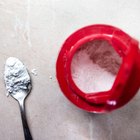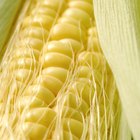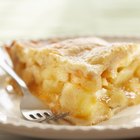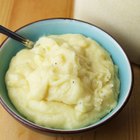Toonzzz/iStock/GettyImages
A Thick, Comforting Sauce for a Fine Comfort Food
All you really need to thicken a batch of creamed corn is patience. The longer you cook it, the more liquid will evaporate and the thicker the final result will be. However, this strategy requires you to cook away most of the sauce, so if you like your creamed corn both thick and saucy or if you just don't have the time to cook it all the way down, there are other techniques to help you achieve similar results. The method you choose should depend on the ingredients you have available and the cooking method you use.
The Richness of Cream Cheese
If you make creamed corn in the slow cooker, you'll have an extra challenge trying to get it to thicken: the slow cooking method requires you to cook the creamed corn covered, which seals in the moisture and makes it even harder for the dish to thicken. To solve this dilemma, add a bit of cream cheese to your creamed corn along with the milk and butter. Instead of mixing the cream cheese (and the butter) into the milky corn, spread dollops on the surface. Let them melt and infuse your corn for a few hours, and then stir them in about halfway through the cooking process. Slow cooked creamed corn takes 2 to 3 hours on high or 5 to 6 hours on low. If the mixture seems runny at the end of the cooking process, simply give it an extra stir and let it stand for a few minutes.
The Convenience of Cornstarch
You can find cornstarch in just about any supermarket, and it's easy to use to thicken creamed corn. Instead of adding it directly to the liquid, make a paste of equal parts cornstarch and cold water, and then stir this mixture into your creamed corn once it's just about done. Use 1 tablespoon cornstarch and 1 part cold water for each cup of creamed corn to start, and then repeat with a little more cold water and a little more cornstarch if the first round hasn't produced the thickness you desire. Your creamed corn will have a starchy texture and flavor right after you add the cornstarch paste, but this will cook away after a minute or two. Once the starchiness is gone and your creamed corn is thickened to your satisfaction, it's ready to serve.
The Simplicity of Rice Flour
While cornstarch requires the extra step of making a slurry before adding it to your creamed corn, rice flour thickens more directly. Simply sprinkle some on the surface of your creamed corn, and stir. If you sprinkle it rather than dumping it in you'll avoid unappealing lumps, and if the first round doesn't yield the thickness you desire, simply sprinkle in a bit more. Unlike cornstarch, which is widely available, you're more likely to find rice flour in a natural food store than in a mainstream supermarket.
Related Articles

How to Make Corn Soup

Why Is My Boiled Corn Chewy?

How to Make Pan-Fried Corn

How to Boil Sweet Corn in Milk

Can You Use Konjac Flour in Baking?
Can You Use Masa Harina in Cornbread?
How to Tenderize Corn

Corn Starch Vs. Baking Powder in Cooking

How to Roast Corn in a Pan

How Long Do Ears of Corn Take to Roast ...
Can You Eat Bulgur Like Oatmeal?

Nutrition Value of Corn Meal

How Much Flour to Thicken a Sauce?

How to Make Hominy With Baking Soda

How to Thicken Chili with Cornmeal

How to Thicken Creamed Corn

What Can I Substitute for Cornstarch?

How to Make Cornmeal Polenta
How to Cook Grits in the Microwave

How to Get Half & Half to Thicken
References
Tips
- Cornstarch won't alter the taste of the creamed corn, and it is a thickener that works well with dairy products.
- Allow the creamed corn to cook down before jumping right in with the cornstarch, or it might end up too thick.
Writer Bio
Devra Gartenstein is a self-taught professional cook who has authored two cookbooks: "The Accidental Vegan", and "Local Bounty: Seasonal Vegan Recipes". She founded Patty Pan Cooperative, Seattle's oldest farmers market concession, and teaches regular cooking classes.